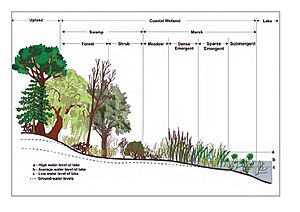Upland game bird facts for kids
Upland game bird is a term used in America for certain birds that live on dry land, away from water. These birds are often hunted for sport. They are called "upland" because they live in higher, drier areas like fields and forests, not in wet places like swamps or near rivers. Hunters often use trained dogs, like pointers or retrievers, to help them find these birds.
Types of Upland Game Birds
Many different kinds of birds are considered upland game birds. Here are some of them:
- Ring-necked pheasant
- Bobwhite quail
- Blue grouse
- Ruffed grouse
- Sharptailed grouse
- Sage grouse
- Hungarian partridge
- Chukar
- California quail
- Snipe
- Woodcock
- Scaled quail
- Prairie chicken
- Mountain quail
- Doves
- Pigeons
- Ptarmigan: This is a common name for birds from the Lagopus family. Some types include:
- Rock ptarmigan (Lagopus muta)
- Willow ptarmigan (Lagopus lagopus) or willow grouse
- White-tailed ptarmigan (Lagopus leucura)
- Wild turkey
Upland Game Birds in the United States
In the United States, the number of upland game birds like pheasants has been decreasing in some farming states. This was noticed around 2013. One big reason is that farmers grew more crops like corn. This meant less land was left for the birds to live in.
Also, fewer people have been hunting these birds over the past 20 years. This change in hunting numbers can also affect how bird populations are managed.


